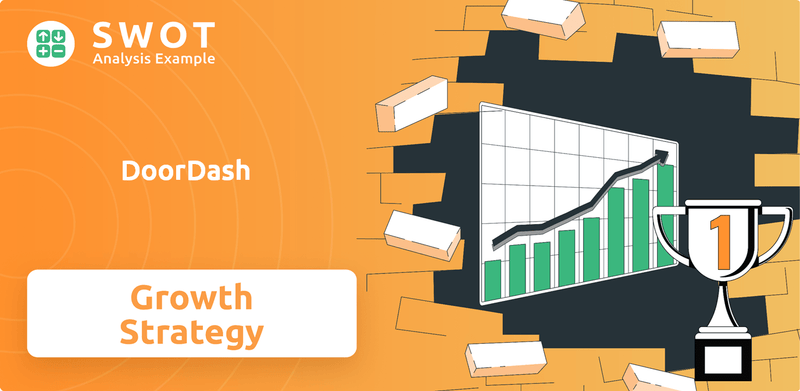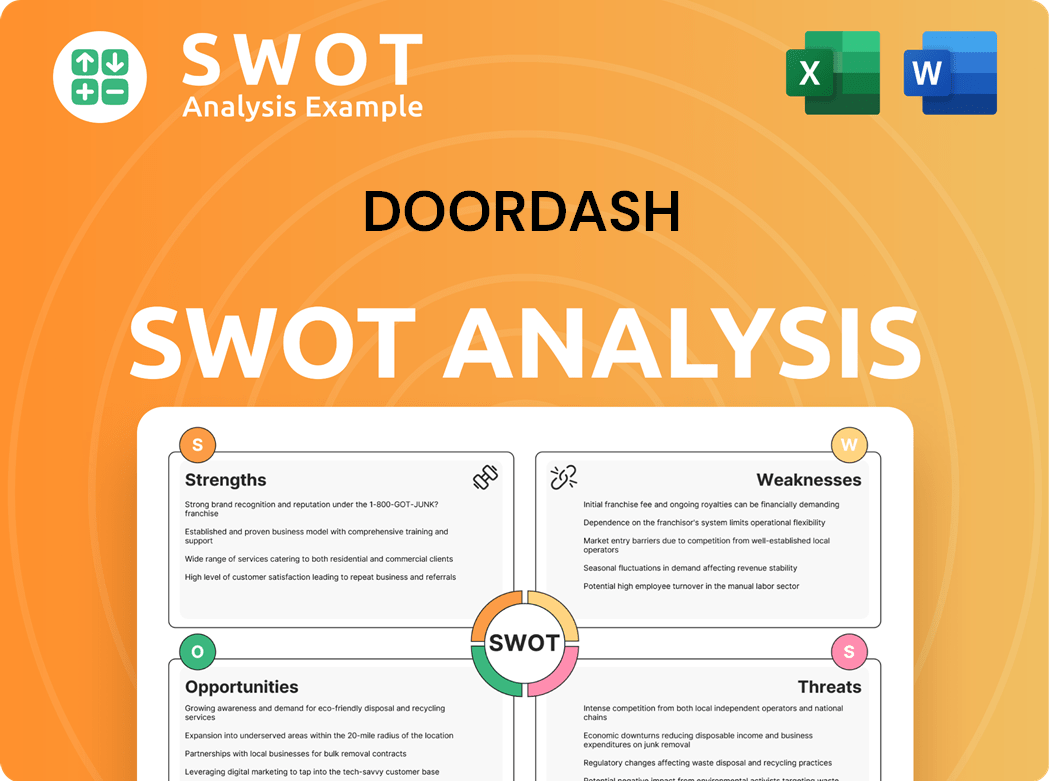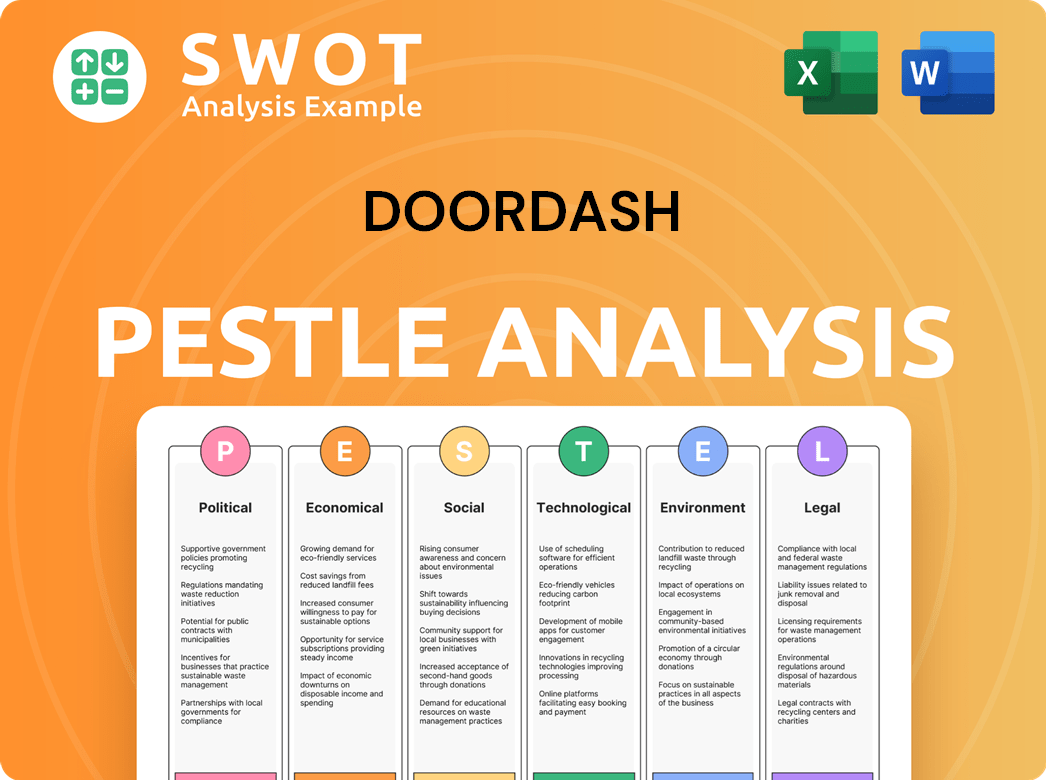DoorDash Bundle
Can DoorDash Continue to Dominate the Food Delivery Game?
Founded in 2013, DoorDash has revolutionized on-demand delivery, rapidly ascending to become a leader in the food delivery market. From its humble beginnings, connecting customers with local businesses, DoorDash has achieved remarkable growth, boasting a significant market share and impressive financial results. This article delves into the DoorDash SWOT Analysis, exploring its strategic initiatives and future trajectory.

DoorDash's impressive financial performance, including substantial revenue growth and positive net income, highlights its strong position in the gig economy. With a rapidly expanding user base and the food delivery market projected to surge, understanding DoorDash's growth strategy and future prospects is crucial. This comprehensive DoorDash company analysis examines its expansion plans, technological advancements, and the competitive landscape to provide actionable insights for investors and strategists alike.
How Is DoorDash Expanding Its Reach?
The Target Market of DoorDash is expanding rapidly. DoorDash is actively implementing a multi-faceted growth strategy to strengthen its market position and diversify its revenue streams. This strategy includes aggressive international expansion and diversification of its service offerings.
DoorDash's approach includes strategic acquisitions and expansion into new product categories. These initiatives aim to broaden its customer base, diversify revenue, and adapt to industry changes. The company anticipates a 15% annual revenue growth over the next five years, demonstrating its commitment to long-term expansion and market leadership.
DoorDash's strategic moves are designed to evolve it from a food delivery service into a comprehensive local commerce platform. This evolution is supported by acquisitions and partnerships that expand its service offerings and geographic reach. The company's focus is on adapting to diverse market environments and consumer needs.
DoorDash is aggressively expanding internationally, primarily through acquisitions. The acquisition of Wolt, a European food delivery service, significantly increased its geographic footprint. This expansion allows DoorDash to replicate its domestic success in new markets.
DoorDash is diversifying its services beyond food delivery. The company is expanding into grocery and convenience store delivery. Partnerships with retailers like Home Depot and Albertsons support this expansion, offering customers a wider range of products.
DoorDash is acquiring companies to enhance its offerings and enter new markets. The acquisition of SevenRooms, a hospitality platform, aims to provide merchants with advanced tools. These acquisitions are part of DoorDash's broader strategy to diversify and grow.
DoorDash is projecting significant financial growth through its expansion initiatives. The company anticipates a 15% annual revenue growth over the next five years. This growth is driven by new services and geographic expansion, solidifying its market leadership.
DoorDash's expansion initiatives include strategic acquisitions, service diversification, and geographic expansion. These efforts are designed to increase market share and revenue streams. The company is focusing on both organic growth and strategic partnerships to achieve its goals.
- International Expansion: Acquisitions like Wolt and Deliveroo.
- Service Diversification: Expanding into grocery and convenience store delivery.
- Strategic Partnerships: Collaborations with retailers and financial institutions.
- Technological Advancements: Integration of new technologies to improve service.
DoorDash SWOT Analysis
- Complete SWOT Breakdown
- Fully Customizable
- Editable in Excel & Word
- Professional Formatting
- Investor-Ready Format

How Does DoorDash Invest in Innovation?
The ongoing success of DoorDash is significantly influenced by its strategic use of technology and continuous innovation. The company focuses on both internal development and collaborations to improve its platform and service offerings, aiming to enhance efficiency and customer experience through digital transformation and automation.
A key aspect of DoorDash's technological approach involves leveraging data analytics and artificial intelligence (AI) to optimize operations. This includes the use of machine learning to enhance various aspects of its services, such as identity verification for its delivery personnel.
DoorDash's commitment to technological advancement is evident in its platform's design, which prioritizes ease of use for consumers and provides aggregated data to help providers improve customer experience and inform business decisions. This strategic focus is expected to drive growth, with increased capital expenditures planned for developing new technologies.
DoorDash utilizes AI and data analytics to enhance its operational efficiency and customer experience. In 2024, the company's AI capabilities helped identify undervalued stocks, demonstrating its advanced analytical skills.
The company is actively implementing machine learning technology for more frequent identity re-verification of its Dashers. As of December 2024, over 150,000 Dashers were required to re-verify their identity each week.
DoorDash is exploring cutting-edge technologies to enhance delivery capabilities, such as drone delivery services. This initiative, launched in partnership with Wing in Charlotte, North Carolina, highlights its forward-looking approach to logistics.
The Dasher Preferences tool allows drivers to customize their delivery options, such as opting in or out of grocery and alcohol deliveries. This enhances flexibility and optimizes delivery assignments.
The platform design prioritizes ease of use for consumers and provides aggregated data to help providers improve customer experience. This approach supports the company's growth objectives.
DoorDash continues to invest in enhancing its platform for consumers, merchants, and couriers, which is expected to contribute to its growth objectives. Increased capital expenditures are planned to develop new technologies.
DoorDash's strategic investments in technology and innovation are critical components of its mission and future prospects. These advancements not only improve operational efficiency but also enhance the overall user experience for customers, merchants, and delivery personnel. The company's focus on leveraging AI, machine learning, and exploring new delivery methods like drone services positions it well within the competitive food delivery market and the broader on-demand delivery sector. This commitment to innovation is a key driver of its sustained growth.
DoorDash's technological advancements span several areas, including AI-driven analytics, machine learning for enhanced security, and exploration of drone delivery services. These innovations aim to streamline operations and improve user experience.
- AI-Powered Analytics: Utilized for identifying market opportunities and optimizing operational efficiency.
- Machine Learning for Security: Implemented for frequent identity verification of Dashers, enhancing platform security.
- Drone Delivery: Exploring drone technology to improve delivery speed and efficiency, as seen in the partnership with Wing.
- Dasher Preferences: Allowing drivers to customize their delivery preferences, increasing flexibility and optimizing assignments.
DoorDash PESTLE Analysis
- Covers All 6 PESTLE Categories
- No Research Needed – Save Hours of Work
- Built by Experts, Trusted by Consultants
- Instant Download, Ready to Use
- 100% Editable, Fully Customizable

What Is DoorDash’s Growth Forecast?
The financial outlook for DoorDash appears robust, supported by strong performance in 2024 and early 2025. The company's ability to achieve profitability and significant revenue growth indicates a positive trajectory. This performance is particularly noteworthy within the context of the competitive food delivery market and the broader on-demand delivery sector.
DoorDash's financial health is further underscored by its increasing cash flow and strategic financial decisions. The company's focus on marketplace expansion and strategic investments suggests a commitment to sustained growth and long-term value creation. For a deeper understanding of the company's financial structure, consider exploring the information available to Owners & Shareholders of DoorDash.
The company's strategic initiatives and anticipated revenue growth over the next five years highlight its potential to maintain a strong position in the gig economy.
In 2024, DoorDash reported a revenue of $10,722 million, a 24% increase year-over-year. This growth was primarily driven by a 20% increase in Marketplace Gross Order Value (GOV) to $80.2 billion. The company's revenue continued to grow in Q1 2025, reaching $3.0 billion, a 21% year-over-year increase.
DoorDash achieved its first full year of positive GAAP net income in 2024, reporting $123 million, a significant turnaround from a net loss of $(558) million in 2023. In Q1 2025, the company reported a GAAP net income of $193 million, reversing a net loss of $23 million in Q1 2024.
Total orders reached 732 million in Q1 2025, an 18% increase from Q1 2024. Marketplace GOV climbed 20% to $23.1 billion in Q1 2025. These figures reflect the increasing demand for on-demand delivery services.
Adjusted EBITDA reached an all-time high of $590 million in Q1 2025, up 59% from Q1 2024. This indicates improved operational efficiency and profitability.
Cash flow from operating activities increased from $252 million in 2020 to $2.1 billion in 2024, and is projected to reach $2.6 billion in 2025. The board authorized the repurchase of up to $5.0 billion of its Class A common stock in February 2025.
Analysts project DoorDash's revenue to grow 15% annually on average over the next five years. The company plans to invest in business expansion and strategic initiatives to increase its scale and long-term profit potential in 2025 and beyond.
DoorDash Business Model Canvas
- Complete 9-Block Business Model Canvas
- Effortlessly Communicate Your Business Strategy
- Investor-Ready BMC Format
- 100% Editable and Customizable
- Clear and Structured Layout

What Risks Could Slow DoorDash’s Growth?
The path to continued success for DoorDash, while promising, is fraught with potential pitfalls. The company's DoorDash growth strategy faces significant challenges that could impact its DoorDash future prospects. Understanding these risks is crucial for any DoorDash company analysis.
Intense competition within the food delivery market is a constant concern, with rivals like Uber Eats and Grubhub aggressively pursuing market share. Furthermore, regulatory changes and macroeconomic factors present considerable hurdles that require proactive management and strategic adaptation. These factors could affect the company's financial performance and operational flexibility in the evolving on-demand delivery landscape.
One of the most pressing challenges DoorDash faces is the competitive landscape. While DoorDash held a dominant 67% of the U.S. meal delivery market share in March 2024, as reported by Bloomberg, this dominance is constantly under threat. Competitors are consistently innovating and offering incentives to attract both consumers and delivery drivers. Maintaining and growing market share requires significant investment in marketing, technology, and operational efficiency, which can strain profitability.
Regulatory changes concerning labor laws and driver classification pose a substantial risk. The debate over whether delivery drivers should be classified as independent contractors or employees has wide-ranging implications for labor costs and operational flexibility.
Changes in labor laws, such as those in British Columbia in September 2024, which mandate minimum wage entitlements and workplace protections for app-based gig workers, could significantly increase DoorDash's expenses. The European Union is also implementing directives to improve working conditions for platform workers.
DoorDash is proactively engaging with policymakers and exploring alternative business models to mitigate the financial impact of potential regulatory changes. This includes lobbying efforts and exploring ways to adapt to evolving labor standards.
Potential market saturation, especially as the company expands internationally, presents another risk. Reaching new customers and maintaining growth in already competitive markets requires significant investment and innovative strategies.
The ongoing need for significant technological investments, which can strain short-term finances, is another challenge. Keeping up with technological advancements is crucial for maintaining a competitive edge, but it requires substantial capital expenditure.
Supply chain vulnerabilities and macroeconomic headwinds, such as fears of recession and inflation, could impact consumer spending and demand for delivery services. These external factors are beyond DoorDash's direct control but can significantly affect its performance.
DoorDash is actively addressing these risks through strategic diversification, such as expanding into grocery and alcohol delivery, and by focusing on operational efficiency. These initiatives aim to create multiple revenue streams and improve profitability.
The company is also strengthening safeguards and implementing identity re-verification for Dashers to address operational risks related to platform integrity. These measures help maintain trust and security within the platform.
For a deeper dive into the competitive dynamics, consider exploring the Competitors Landscape of DoorDash.
DoorDash Porter's Five Forces Analysis
- Covers All 5 Competitive Forces in Detail
- Structured for Consultants, Students, and Founders
- 100% Editable in Microsoft Word & Excel
- Instant Digital Download – Use Immediately
- Compatible with Mac & PC – Fully Unlocked

Related Blogs
- What are Mission Vision & Core Values of DoorDash Company?
- What is Competitive Landscape of DoorDash Company?
- How Does DoorDash Company Work?
- What is Sales and Marketing Strategy of DoorDash Company?
- What is Brief History of DoorDash Company?
- Who Owns DoorDash Company?
- What is Customer Demographics and Target Market of DoorDash Company?
Disclaimer
All information, articles, and product details provided on this website are for general informational and educational purposes only. We do not claim any ownership over, nor do we intend to infringe upon, any trademarks, copyrights, logos, brand names, or other intellectual property mentioned or depicted on this site. Such intellectual property remains the property of its respective owners, and any references here are made solely for identification or informational purposes, without implying any affiliation, endorsement, or partnership.
We make no representations or warranties, express or implied, regarding the accuracy, completeness, or suitability of any content or products presented. Nothing on this website should be construed as legal, tax, investment, financial, medical, or other professional advice. In addition, no part of this site—including articles or product references—constitutes a solicitation, recommendation, endorsement, advertisement, or offer to buy or sell any securities, franchises, or other financial instruments, particularly in jurisdictions where such activity would be unlawful.
All content is of a general nature and may not address the specific circumstances of any individual or entity. It is not a substitute for professional advice or services. Any actions you take based on the information provided here are strictly at your own risk. You accept full responsibility for any decisions or outcomes arising from your use of this website and agree to release us from any liability in connection with your use of, or reliance upon, the content or products found herein.